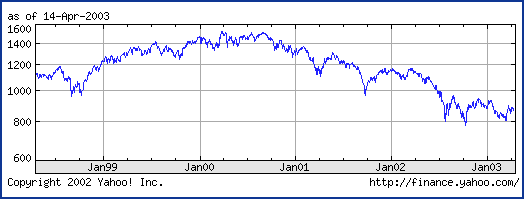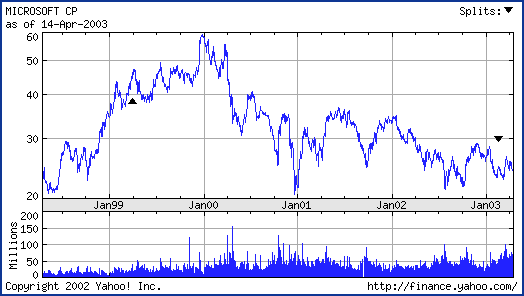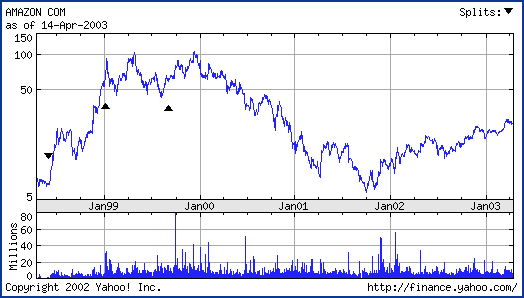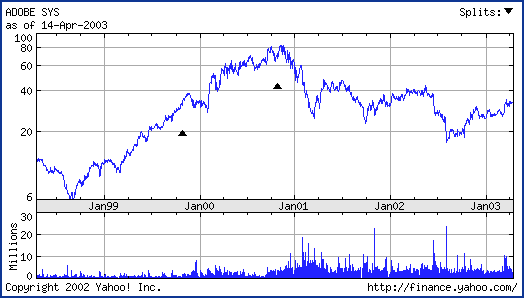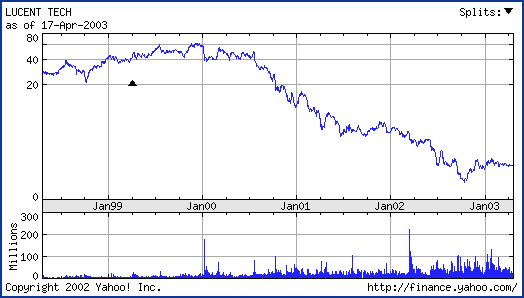
HOT TOPICS LIST
- Strategies
- Stocks
- Buy
- Investing
- Brokers
- Psychology
- Interviews
- Accumulate
- Sell
- Hold
- Spotlight
- Websites
- Candlestick Corner
- Gold & Metals
- Options Trading
LIST OF TOPICS
Stock-Split Trading
01/21/04 04:16:55 PM PSTby Ihor Vysotskyy
Two stocks are better than one.
| Stocks that are at the split stage provide good possibilities and odds for traders. Everybody knows that there is no "Holy Grail" — a winning strategy that works all the time — but stock-split trading works very well in a rising market.
WHY SPLIT?The main reason companies split their stock is to make that stock more affordable to investors. The idea, based on psychological factors, is that more people will buy a company's shares for $40 each than for $80. With more people buying cheap shares, the share price goes up. Another reason a company may want to have a stock split is to increase the number of shares for sale. Financial institutions do not want to have deals with thinly traded stocks, because the lack of shares on the market can cause greater volatility in price. When the stock splits, there are more shares outstanding, so buying and selling will have less impact on the price.
SOME EXAMPLESTake a look at Figures 1-5. These show the Standard & Poor's 500 Index and four companies, namely Microsoft (MSFT), Amazon (AMZN), Yahoo! (YHOO), and Adobe (ADBE). The four companies had stock splits during the last five years (see the triangle sign on the charts). As you can see in Figure 1, until mid-2000 the market was bullish, and a bearish market began toward the end of 2000. During the bullish market, the companies in Figures 2-5 had stock splits that increased the price of the stocks, at least in the short term. For example:
Figure 1: The S&P 500 Index. To get a general idea of which way the market is heading, it's best to look first at a chart of one of the broader indexes.
Figure 2: Microsoft Corp. (MSFT). Note what happens to price after a split in a bull and a bear market.
Figure 3: Amazon Systems (AMZN)
Figure 4: Yahoo!, Inc. (YHOO)
Figure 5: Adobe Systems (ADBE)
Some of these companies had splits during a bearish market. For example, MSFT split 2-to-1 on February 18, 2003; YHOO split on February 14, 2000; and ADBE split on October 25, 2000. However, these splits did not result in any positive increase in the price of their stocks. In a bearish or flat market, splits don't make things better or worse than the market on the whole. If the market is bearish, then the splits cannot help move a company's stock price higher. Stock splits offer excellent trading opportunities for traders and investors who understand the market impact of these dynamic events. Though some might think that a stock split is simply an accounting function that has no bearing on the stock value, research shows that stock splits frequently have a positive effect on share prices in a bull market — at least in the short term. Company executives and boards of directors realize that splits are one of the most powerful marketing and investor relations tools. They make shareholders feel positive about their investment, and they engender a sense of increased wealth with little expense to the company. Most stocks that split belong to leading companies with growing trends. These companies split their stocks in order to keep their prices in a limited range. If stocks are not moving up, companies rarely have the necessity or desire to make splits. Not all stocks split 2-for-1. Other popular ratios for stock splits are 3-for-1, 3-for-2, and 5-for-4. However, the same principle holds true regardless of the ratio. The stock price will decline and the quantity of shares outstanding will increase. For example, suppose XYZ company has 20 million shares of common stock outstanding and its current price is $80. After the split, XYZ will have 40 million shares of stock outstanding and the stock price will be $40. There are two key dates for stock splits: the announcement date and the execution date. These dates are the most interesting for traders and investors because they are associated with stock price movements. If you buy stocks before the execution date, you will see the effect of the split in your account. Stock splits work because:
Here are the dynamics of stock price changes at the stages of pre-split and post-split:
Companies sometimes announce a reverse split, which means that stock owners get fewer shares. If a company announces a reverse split of 1-for-10, then instead of 100 shares the investor will have only 10 shares. The main reason a company might announce a reverse split? A company might do this because it has too many outstanding shares or very small or no profit, and no interest from investors. The company makes a reverse split, hoping to reinforce investors' interest in its stock. For example, on October 18, 2002, Lucent Technologies (LU) announced a reverse split [1:10]. Shareholder votes gave the board discretion to execute a reverse split of 1-to-10, 1-to-20, 1-to-30, or 1-to-40 until February 19, 2004. The price of Lucent stock was $1.50 per share (Figure 6) and the company had weak financial results. The reverse split eliminates a lot of the company's shares from the market. If the company makes a profit, then earnings per share will be higher because of the smaller number of outstanding shares. But usually it does not help, because these companies often have serious problems and cannot get investments. Decreasing outstanding shares is only the first step toward increasing the price of a stock. Of course, the main reason investors and traders buy shares is to get a good profit or a large cash flow, or because the stock price is undervalued, or a combination of these factors. Companies that announce reverse splits rarely have such characteristics.
Figure 6: Lucent Technologies (LU). When stock prices fall too low it sometimes becomes necessary for management to consider a reverse split.
The reverse split often forecasts an even worse situation for the company. If it appears a company is going to make a reverse split, then you have to check its financial situation before including such a stock in your portfolio. It's quite the opposite of when a company announces a stock split, which implies that the price trends have been, and are likely to continue to be, positive.
Ihor Vysotskyy lectures at Lviv Polytechnic National University in Ukraine. He can be reached at ivoption@yahoo.com. REFERENCES Yahoo! Finance
Current and past articles from Working Money, The Investors' Magazine, can be found at Working-Money.com.
|
| E-mail address: | ivoption@yahoo.com |
PRINT THIS ARTICLE

|

Request Information From Our Sponsors
- VectorVest, Inc.
- Executive Premier Workshop
- One-Day Options Course
- OptionsPro
- Retirement Income Workshop
- Sure-Fire Trading Systems (VectorVest, Inc.)
- Trading as a Business Workshop
- VectorVest 7 EOD
- VectorVest 7 RealTime/IntraDay
- VectorVest AutoTester
- VectorVest Educational Services
- VectorVest OnLine
- VectorVest Options Analyzer
- VectorVest ProGraphics v6.0
- VectorVest ProTrader 7
- VectorVest RealTime Derby Tool
- VectorVest Simulator
- VectorVest Variator
- VectorVest Watchdog
- StockCharts.com, Inc.
- Candle Patterns
- Candlestick Charting Explained
- Intermarket Technical Analysis
- John Murphy on Chart Analysis
- John Murphy's Chart Pattern Recognition
- John Murphy's Market Message
- MurphyExplainsMarketAnalysis-Intermarket Analysis
- MurphyExplainsMarketAnalysis-Visual Analysis
- StockCharts.com
- Technical Analysis of the Financial Markets
- The Visual Investor

